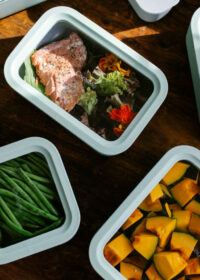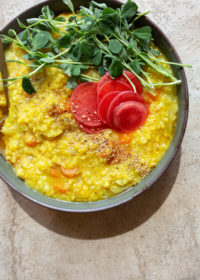Ayurveda: Rasa – The Six Tastes of Ayurveda | Salty

This guest post from Adena Rose Ayurveda is part of a six part series on the essential tastes of Ayurveda – catch the other 5 tastes here!
Did you catch Sweet and Sour? No, it’s not a new Asian soup-virus, I’m referring to my previous two guest posts here on Vidya Living. Taste of food and herbs is the crux of using food as medicine in Ayurveda. Food is more than fuel. Any substance becomes medicinal (or poisonous to our well-being) when we understand its qualities – these qualities tell us how it’s going to affect our mind and body, whether it will bring us into balance, or further out of whack. How can we know? Well, patience and practice, but also through our tongue – taste.
To repeat some of what I said in the introductory post, in order for us to stay balanced physically, mentally and emotionally, we need to be balanced in the qualities we take in. Each of the tastes is a signifier to us how the substance will affect our bodies, and the maha gunas (sattva, rajas and tamas) which govern our state of mind.
Ayurveda explains that there are six tastes: Sweet, Sour, Salty, Pungent, Bitter and Astringent. Some of these may seem obvious, and others more enigmatic. Each of the tastes is also comprised of the five elements, two which are the most dominant. This means that the tastes affect the doshas, Vata, Pitta and Kapha, which are also made of the 5 elements. You can use the chart below to see which tastes ‘subdue’ which doshas, and which elements each taste contains. In Ayurveda, like increases like. If we want to lessen the effects of a dosha which is showing up as too high, we will eat foods with the tastes that have elements which are not the same as those in the dosha which is out of whack – those ‘subdue’ the dosha.


Beyond the tastes, of course we want to ingest food full of prana, the life-force energy, and we also want to be sure we are chewing our food slowly, and digesting it fully. Those topics are beyond this post for now, but you can find general Ayurvedic tips for optimal digestion on my blog.
Lavana : Salty
I could name my first daughter lavana, that’s how much I love the sanskrit word for ‘salty.’ And what an interesting taste to discuss – it’s action in the body is so specific, and very few actual herbs and foods have the salty taste. The salty taste comes from a mineral and chemical compound, sodium, and is found in ancient seas, or living ones. Pronouncing the ‘la’ sound at the beginning of this word reminds me that the salty taste affects the tongue, just as eating something salty causes salivation immediately. And that is just the ayurvedic elemental compound of the salty taste: Fire and Water.
We salt our food to enhance its flavors. The water element is functionally related to the tongue according to Ayurveda. Tasting salt stimulates the flow of the water element in the form of saliva, and saliva is the liquid medium in which chemicals are carried to taste receptor cells. If the water element is affected in the body, the tongue or sense of taste will also be affected – for example a dry mouth or throat being a sign of dehydration. The fire element in salty taste is manifested in the enzymes found in the saliva that is stimulated upon tasting, which begin the process of digestion in the mouth. The effects are the same within the other mucus membranes in the body, including in the stomach and the intestines. Sodium serves a few purposes in the human body: it helps nerves and muscles to function correctly, and it is an important factor in the regulation of water content. If there is too much sodium in our food, our cells will become dehydrated, because too much water will flow out to try to maintain the appropriate balance in the rasa and rakta tissues – our blood stream. Salt is also sometimes used to preserve food. In some culturally traditional foods like cured meats and salted fish, a large amount of salt is used to hold the excess water, which could breed bacteria or fungus and otherwise spoil foods.
Salt is considered to be hot, heavy and moist. Ayurvedic medicine recommends small amounts of salt in food to increase agni. This means that its use can encourage an appropriate amount of moisture and enzymes to flow to aid in proper digestion. The qualities listed above, though, can aggravate both Kapha and Pitta in excess. Too much salt causes too much of the water element to stick around, dampening agni and increasing Kapha dosha. An excess of salt can also cause edema due to the quality of salt to retain water. The hot and liquid qualities also aggravate Pitta dosha, which is made up of both the fire and the water elements. Remember that in Ayurveda, like increase like – so even too much of a good thing will throw us off balance.
The salty taste best used to balance Vata dosha and improve agni. In this role, we say that salt performs a deepana action at meal times. Deepana substances enkindle agni, improving digestion. A popular digestive aid involves slices of fresh ginger, a squeeze of lime juice, and a pinch of salt. Try using this about 20 minutes before meals if you’re one who experiences sluggish digestion, or gas and bloating – or if you’re preparing to eat something cold or heavy, like ice cream or a holiday meal. If you tend to run hot (pitta imbalance), this might be one to avoid.
So where to find the salty taste? Most of us equate salt with our simple table salt, which is mostly sea salt. Often in ayurvedic recipes, rock salt is recommended. Rock salt can be clear or white, but also light blue or pink, depending on the additional minerals found within. Himalayan salt is a common one, and it is light pink or orange. It is mined for within the mountains, but these deposits actually came from the drying up of ancient seas. Rock salt is considered to be the ‘best’ salt to use, because it may be less aggravating for the doshas. I believe this may be because there are other minerals, including iodine, found within the ‘impurities’ of rock salt. Supposedly it has fewer negative effects for those who may have high blood pressure, and may be particularly beneficial in muscle cramps. Foods that are salty include seaweeds like kombu and wakame. Most miso paste is salty, and so are soy sauce and tamari. Many of these foods also have iodine in them, which is why they are beneficial for the thyroid. These foods are all considered beneficial for balancing Vata dosha. Remember, since Vata being dry, cold, light, rough, subtle and mobile, it can benefit from the warming and moistening qualities brought to the tissues by the salty taste. Shilajit is a popular Ayurvedic supplement which is considered to have a salty flavor. Shilajit is a mineral substance that is collected from rocks high in the Himalayas – but it is not only made up of sodium. This ‘herb’ is actually often used for Kapha imbalances in the joints and the urinary tract (like kidney stones, perhaps). It is considered pungent, and also has a scraping action, both qualities which balance Kapha.
As always with Ayurveda, a healing diet is a personal exploration. There are so many subtleties to these ‘rules,’ and each of us is an individual expression of the elements.
References:
BanyanBotanicals.com
Eat Taste Heal, An Ayurvedic Cookbook for Modern Living. Yarema, Rhoda, Brannigan
————————————


 [wpmenucart]
[wpmenucart]


